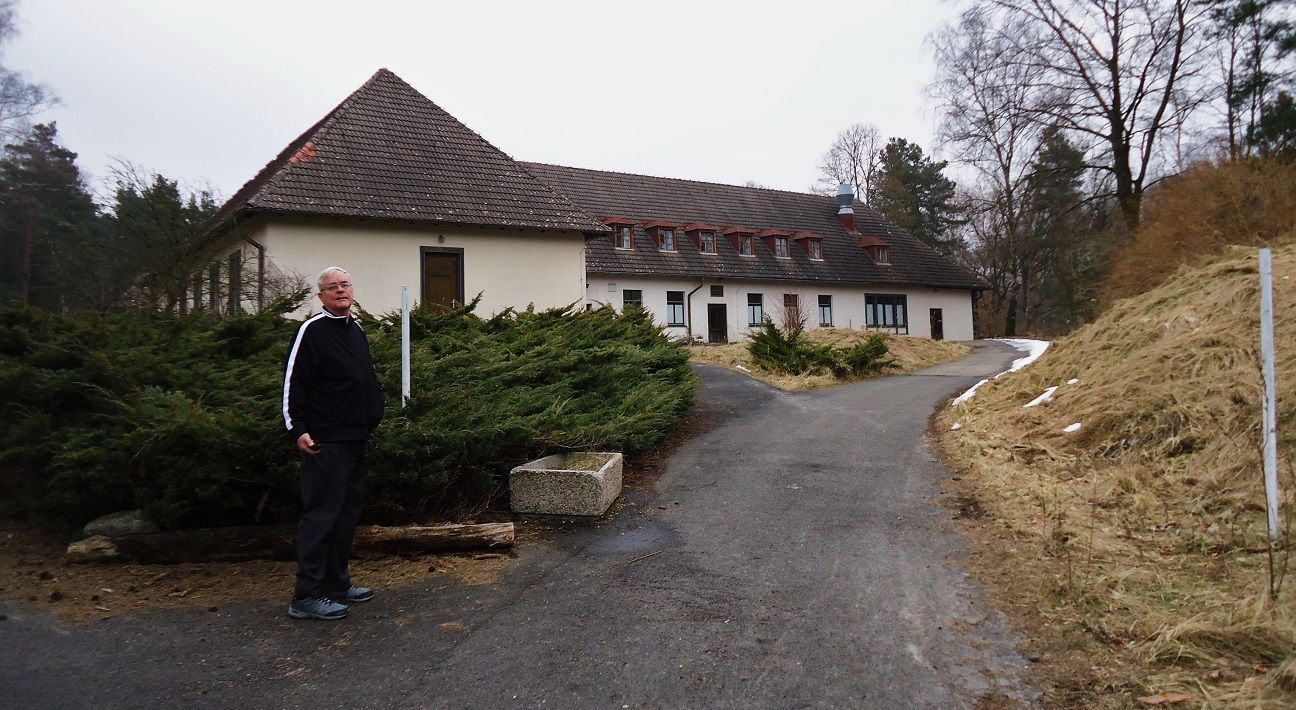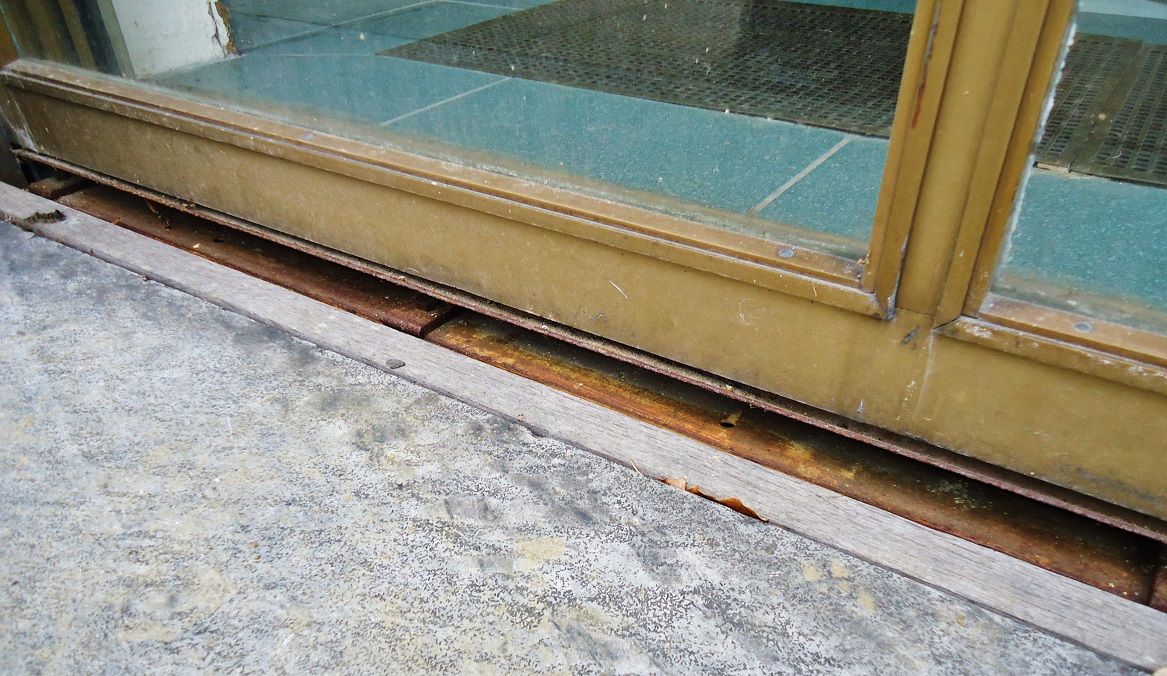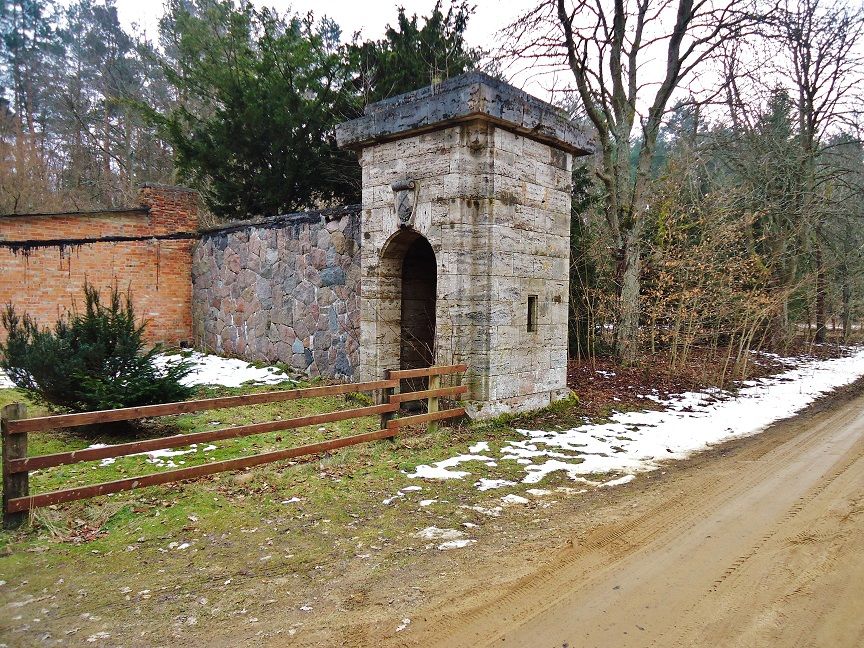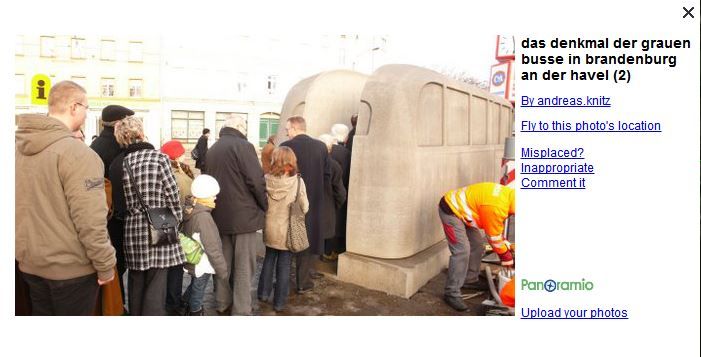|
|
Post by Karl Welteke on Jun 14, 2013 16:48:21 GMT 8
Goebbels Home at Bogensee & FDJ School On our 2nd day we operated north of Berlin. Our 4th stop was the Goebbels Bogensee Home. Much can be found in the www about Goebbels. This album is strictly about his Bogensee home and the FDJ Training Center the East Germans had built here. I have posted 30 images of that visit and they are in this album: www.flickr.com/photos/44567569@N00/sets/72157634318159454/Here are some sample images:  1-This is the former Goebbels, the Propaganda Minister’s garage at his Bogensee home. The area of Goebbels’s Bogensee home had become a large FDJ Training Center of East Germany. FDJ stands for Freie Deutsche Jugend = Free German Youth, a communist replica to the Nazi’s Hitler Jugend. We arrived, parked near this former Goebbels garage, it seems it was used by the communists for the same purpose.  2-We are approaching the Goebbels Bogensee home, right is the Goebbels Bunker. We will circle the Goebbels Bogensee home counter clockwise. The Goebbels family had an exclusive home on the Schwanenwerder Island in the Havel River in Berlin but when the Allied Bombing became more severe he moved his family here. Goebbels had used this complex as a love nest. Because of his power as the Minister of Propaganda and the film industry he had affairs with German film starlets. He had a serious affairs with a Czech actress and Mrs. Goebbels asked Hitler for help who gave Goebbels the riot act. I assume the affairs stopped and Goebbels settled down after that.  3-This map, marked up be me, gives you the layout of what we seen or what we know about the Goebbels Bogensee home and the East German FDJ Training Center.  4-These are windows, reaching all the way to the ground and can be lowered completely into the ground, out of sight, to open a large room to the outside. We are in back of the house which could be called a terrace. The Nazi Government of the City of Berlin (this property belonged to the Berlin City) gave this property to Goebbels in 1936 and he built this home.  5-bunker near the NE wing of the Goebbels Bogensee home, I suspect it housed a generator.  6-This is what you can see from the bomb proof bunker next to the Goebbels Bogensee home. Behind it at right is a compound used by the Berlin Forestry. One news magazine says that the forestry is using the former Goebbels Block House next to the Bogensee but I didn’t see it nor do I know exactly where it is. This so called block house was Goebbels first structure here and was used by him as his love nest or what the Japanese call a Love-Hotel.  7-This is a captured screen shot of an aerial view of the former Goebbels Bogensee home and the ex East German FDJ complex from the Panoramio web pages by CT-Flieger |
|
|
|
Post by Karl Welteke on Jun 15, 2013 8:27:27 GMT 8
Goering’s Carinhall Goering was officially the No. 2 man in the 3rd Reich and he built this place and named it after his deceased 1st wife. This must be Swedish spelling, in German one would normally say Karinhalle. There is so much to read in the www that I don’t need to elaborate more on him. On our 2nd day we operated north of Berlin. Our 3rd stop was Goering’s Carinhall. This album is strictly about his Carinhall. We actually missed it and had driven by. It was blown up and is laying hidden in the woods. The entrance gate and the guard detachment facilities still exist and that is all we did get to see. I have posted 11 images of that visit and they are in this album: www.flickr.com/photos/44567569@N00/sets/72157634122115334/Here are some sample images:  1-These are the two remaining guard posts at the entrance to the Goering’s Carinhall estate. This was basically the fist view when we arrived here. I explained on the picture how we missed Carinhall. Our car is already turned around for us to leave.  2-We drove on this road towards the two guard posts, what seemed to me forever and I thought, Jesus why did Goering like such a long way to get to Carinhall. On this Google image I tried to explain how we went wrong and that we missed Carinhall.  3-We are looking somewhat east and at right is the south guard detachment office and quarters building. We thought it was strange that the buildings were outside the guard posts.  4-This image map explains the guard post geography and it’s relation the actual Carinhall location.  5-The south guard post at the entrance to the Goering Carinhall estate.  6-Ruins of Carinhall. This image came from Google Earth where it was posted from the sources as indicated. This reminds me of the ruins on Corregidor in the woods.  7-The concrete bases for a searchlight tower the captured image says. Again this reminds me at Corregidor. This image came from Google Earth where it was posted from the sources as indicated.  8-Goering’s Carinhall was a an expensive place, this was his library. As far as I can tell this picture came from the Library of Congress.  9-Another impressive hall from Carinhall. As far as I can tell this picture came from the Library of Congress.  10-This is a 1:500 meter drawing of Carinhall. This image came from this URL: www.theempressofdress.com/2012/11/24/carinhall/Called -The Empress of Dress-Maintain sartorial elegance all of your life.  11-This 1995 news paper clipping says -clean-up at Carinhall-. It says Claus Funke discovered the buried entrance to the bunker and many broken pieces of artwork were found and turned over to a Berlin Museum, that why they said -clean-up-. Sarcastically it also said this-Goering built it in 1939, when he told the German public as the head of the Luftwaffe that if one bomb would fall onto Germany they could call him Meier-. In other words in 1939 he didn’t believe himself what he had said!!!! This paper clipping came from here: www.bunker-ig.de/intro/start/bunker/alte_bunker/carinhall/body_carinhall.html 12-Carinhall, from this URL: www.theempressofdress.com/2012/11/24/carinhall/Called -The Empress of Dress-Maintain sartorial elegance all of your life. |
|
|
|
Post by Karl Welteke on Jun 17, 2013 12:22:54 GMT 8
Brandenburg Prison, Nazi Execution Site Brandenburg-Goerden Prison, Justizvollzugsanstalt, JVA, Brandenburg Prison The Memorial Organization says this about the Brandenburg Prison: The new prison of Brandenburg (Havel) was built between 1927 and 1935. The prison had a capacity of 1,800 internees. The Nazi's used it from 1933 till 1945, to imprison 'dangerous elements'. The prison population mainly consisted of criminals, political prisoners, draft resisters and POW's. The execution room (see picture) was established in 1940. From August 1940 till April 1945, some 1,722 prisoners were executed here. 652 other prisoners perished due sickness and 6 committed suicide. The prison was liberated on 27 April 1945 by the Red Army. After the war, the prison was used by the NKVD till 1947 for detention of collaborators and high-ranking members of the 'Russian Liberation Army' (ROA). In 1949/1950, the GDR took over the prison. The web page of the prison memorial says “It was the most feared prison during the East German regime”. On the morning of the 11th April 2013, our 3rd day of travel, we drove to the Brandenburg Prison, it was a rainy day. Steve had arranged for an appointment, they took our passports and we entered. The prison is known under many names, the correct one now is Justizvollzugsanstallt (Justice-Executive-Institution).Brandenburg an der (on the) Havel -River. The name Brandenburg-Goerden is used because it is that part of the city. It is also referred to as the new Brandenburg-Prison and common folk like me call the Brandenburg Prison. I put 25 images in this album: www.flickr.com/photos/44567569@N00/sets/72157634151882131/Here are some sample images:  01-After we met our appointed guide, an official and lady, from the Brandenburg Memorial Organization, we were led thru a reception security gate, across an empty ground before the main wall and then thru that main wall.  02-The guillotine in the execution room. The web page says this execution room has been prepared in an authentic way but the guillotine came from an other location but was used during the NS time. The original guillotine in a Berlin Museum.  03-The Brandenburg Prison is undergoing a major renovation but this is the way it looked under the East German regime. Both the Nazi regime and the East Germans used the prisoners as a manufacturing labor force. Under the Nazi regime 600+ prisoners died because of sickness and malnutrition.  04-On this Google Earth image I marked all the relevant locations of this album.  05-In front of the prison is this monument and caught my eye. Of course it is a Soviet tank and was put here to celebrate the liberation of the Brandenburg Prisoners by the Red Army. I bet most prisoners didn’t care that it was the Red Army and would have hugged a Russian soldier. This Wikipedia URL about the Brandenburg Goerden Prison was interesting to me because it lists on the bottom well known people who died here and others who were liberated by the Red Army and later became leading figures in the East German regime. en.wikipedia.org/wiki/Brandenburg-G%C3%B6rden_PrisonFor the states of Brandenburg and Berlin these web pages have nee developed. And this is the sitemap URL. However it is all in German, sorry about that: www.orte-der-erinnerung.de/en/sitemap/ |
|
|
|
Post by Karl Welteke on Jun 17, 2013 19:51:39 GMT 8
Brandenburg an der Havel, Brandenburg City. Birth place of the state of the Kingdom of Prussia and so the German Second Reich in 1871. We are on our 3rd day into the history of the Third Reich. We already looked at the Brandenburg Prison and had to wait for the Euthanasia Memorial to open. So we walked around a little in the City even though it was a rainy day. To me it was most interesting I had never been here. This city was the birth place of the state of Brandenburg, the Kingdom of Prussia and so the German Second Reich in 1871. I was born in the State of Brandenburg and so became a resident of Prussia, in 1942 it wasn’t a kingdom anymore. 22 images have been uploaded into this album:\ www.flickr.com/photos/44567569@N00/sets/72157634176428224/Here are some sample images:  01-The Plauer Torturm (gate tower) of Brandenburg an der Havel (Brandenburg City from now on in here).  02-On this Google Earth map I marked the places we seen.  03-The Brandenburg City Hall. In front of the city hall is the Roland Stature. Roland was legendary knight under Karl the Great the First German Emperor around anno 800. He became a symbol for City rights and City Independence in the Central European History.  04-Walking down Baecker Strasse and the Rathenower Torturm is in sight. At the Rathenower Torturm, we made a right turn and walked along a section of remaining city wall.  05-We are turning a corner at the city wall and the Gotthardtkirche (Church) is in view. One end of the Gotthardtkirche is also being renovated. Note: This Wikipedia URL gives you good information about the birthplace of my heritage: en.wikipedia.org/wiki/Brandenburg_an_der_Havel |
|
|
|
Post by okla on Jun 17, 2013 20:04:31 GMT 8
Hey Karl....Thanks again for presenting us with the North German tour. Very interesting indeed. The view of the
"execution machine" with its' head catching bucket struck a grisly note, I gotta say. I also gotta say that Herr Goring knew how to enjoy life. Karinhall and its obscene luxury was the extreme opposite of grim, dismal Brandenburg Prison. This is really good stuff. Thanks again. Cheers.
|
|
|
|
Post by The Phantom on Jun 18, 2013 0:10:04 GMT 8
I parrot okla's statement Karl, very well pictured and explained.
|
|
|
|
Post by Karl Welteke on Jun 18, 2013 15:05:29 GMT 8
Brandenburg Euthanasia Memorial Centre The Euthanasia Memorial Center is located in the old Brandenburg Prison, in the center of Brandenburg City. It opened in the afternoon but we had a good look. This was our third stop this day after the new Brandenburg prison and killing some time in this town. The memorial Centre reports according to a table compiled in 1942 and discovered in 1945, the so-called Hartheim Statistics, a total of 9,772 people were murdered in a gas chamber at the Brandenburg Euthanasia Centre in 1940. In Aug. 1940 it stopped here but the killing continued in other places and under other programs. In this album I put 26 images: www.flickr.com/photos/44567569@N00/sets/72157634909852780/Here are some sample pictures:  01-In the courtyard are these 4 display columns featuring the death of some of the many victims.  02-This map is marked where the centre is and from Google earth I learned we missed the memorial of the gray busses and behind the centre and next to the Havel River is a Slavic village display. I misspelled -Slavic- on the image!  03-There was an interest to find out what was going on and some notable people tried and got in trouble or lost their life.  04-I like this picture, it may the best picture of the old Brandenburg Prison on the www.  05-This is about another memorial right beside the Brandenburg Euthanasia Center and we missed it. In all the literature there are description about Gray Busses, the windows painted also gray, in which these victims were transported. Most people probably seen these busses at the time. This image is from as indicated on the picture.  06-This picture is also from Google Earth as the last one. It is those 4 columns again but with a different display. I guess that means they change the displays sometime. Note: In my opinion , this is the best web page I found about the Euthanasia Program in Nazi Germany, the Third Reich also called Gross-Deutschland since reunification with Austria. Nazi Propaganda Against the Disabled www.fold3.com/page/286019384_nazi_propaganda_against_the_disabled/ |
|
|
|
Post by Karl Welteke on Jun 19, 2013 8:11:14 GMT 8
Glienicke Bridge, Bridge of Spies The Glienicke Bridge is a bridge on the edge of Berlin that spans the Havel River to connect the cities of Potsdam and Berlin. The current bridge, the fourth on the site, was completed in 1907, although major reconstruction was necessary after it was damaged in WWII. The border between West Berlin and East Germany at Berlin’s west side run right across the middle of the bridge. Bridge of Spies During the Cold War Glienicke Bridge was one of the few places in the world where the Soviet Union and the Western powers stood directly opposite each other. Thus, “deals” could be made here without any of their allies having any say in the matter. The bridge lies at an isolated point where the US-occupied sector of West Berlin met Soviet-occupied Potsdam, which was in East Germany. The United States and the Soviet Union used it four times to exchange captured spies during the Cold War, (the above two paragraphs came from Wikipedia). We are on our 4th day into the history of the Third Reich and we have many stops today. This bridge is certainly a symbol of the East-West Divide. 26 images are in this album about the bridge: www.flickr.com/photos/44567569@N00/sets/Here are some sample images:  01-We approached the bridge from the west. This is the north side. The Glienicke Bridge, looking from west to east, speaking in term of history, looking from Potsdam ex East Germany to the ex West Berlin.  02-The bridge connects Berlin with Potsdam which had become the seat of power of the state of Brandenburg, then the kingdom of Prussia and finally the Second German Reich. During the Cold War it connected the Soviet Union with USA. And I was born in Brandenburg, Prussia so this is real personal history to me!!!!  03-The last exchange between East and West. From Wikipedia-The final exchange was also the most public. On 11 February 1986 the human rights campaigner and political prisoner Anatoly Sharansky and three Western agents were exchanged for Karl Koecher and four other Eastern agents.  04-Nov. 12th 1989 the border is open, UNITED, unbelievable. Germany has Freedom, United and Democracy, I can’t believe it, I’m happy!!! This sign says it all. Here Germany and Europe were divided until 10 Nov. 1989 1800 hours.  05-The Glienicke Bridge is destroyed in 1945. I assume the Germans blew it up in the defense of Berlin. Note: Bridge of Spies During the Cold War Glienicke Bridge was one of the few places in the world where the Soviet Union and the Western powers stood directly opposite each other. Thus, “deals” could be made here without any of their allies having any say in the matter. The bridge lies at an isolated point where the US-occupied sector of West Berlin met Soviet-occupied Potsdam, which was in East Germany. The United States and the Soviet Union used it four times to exchange captured spies during the Cold War. The above paragraph came from this Wikipedia URL which also lists all the spie exchanges in detail: en.wikipedia.org/wiki/Glienicke_Bridge |
|
|
|
Post by Karl Welteke on Jun 19, 2013 21:26:35 GMT 8
Claus von Stauffenberg Our first stop on our 4th day (12th Apr.2013) into the history of the Third Reich was an address in Berlin were Colonel Claus von Stauffenberg had lived 1943-1944. It is Tristanstrasse 8 in Berlin. A plaque has been placed next to the gate to honor his sacrifice and to remember his deed to change the course of the war by killing Hitler. He is of course one of my heroes and I asked had Steve take a picture of me next to the plaque, so I can say I walked were a hero once walked. The house is not available to be visited. Here is my album with 11 images: www.flickr.com/photos/44567569@N00/sets/72157634210373368/Here are some sample images, five of which are from the www, mostly from Wikipedia:  01-Everywhere we went on this North German trip I noticed impressive villas. Just about all of them were built in the 3 to 4 decades before the First World War. It was the golden time for Germany at least for most people. Germany was becoming the most industrialized country in the world. It was the Second Reich, Germany just got united in 1871. I’m sure agriculture was also doing well, someone had to feed the expanding Reich. I think my family farm house must have been built also at that time. But World War One destroyed all that. This house Colonel Claus von Stauffenberg used was built 1905.  02-The location of Tristanstrasse 8 in Berlin, home of Colonel Claus von Stauffenberg 1943-44. Berlin sure has a lot of lakes. Notice it is not far from Potsdam and the Glienicke Bridge.  03-Karl, your’s truly, next to the Remembrance Marker at Tristanstrasse 8 in Berlin. I had to get something to remember this hero.  04-The description is on the picture, to me it is a piece of history. I’m sure not too many people visit this place. I bet my friend Steve, the great navigator, doesn’t have the this PPS position marked yet.  05-What a devastation, such a bad luck, Hitler survived, maybe my life would have been different if Stauffenberg had succeeded.  06-The courtyard of Bendlerblock where Stauffenberg got executed by firing squad.  07-Claus von Stauffenberg was a frequent visitor at the Wolfschanze (Wolf’s Lair).  08-Tom Cruise in his role as Claus von Stauffenberg in the relevant recent movie Valkyrie. If nothing else it made the Hitler assassination attempt wider known. Note: Wikipedia is always a good place to find information fast, here is it’s URL on Colonel Claus von Stauffenberg. en.wikipedia.org/wiki/Claus_von_Stauffenberg |
|
|
|
Post by okla on Jun 19, 2013 23:36:53 GMT 8
Hey Karl...As you said, you will always wonder how your life might have been changed if Hitler had been "taken out" in the summer of 1944. Historians will long ponder what kind of deal the Western Allies might have gotten with his successors. The Americans and Brits could well have occupied the whole of Germany before the Russians could have arrived. Betcha, though, even if this had happened, that we would have withdrawn to approximately the occupations areas that were agreed upon previously. The Reds certainly had a talking point in demanding their "share of the pie". Let me say, I am damned sure glad that things did turn out fairly well for you and your family. You, certainly, have proved out a big positive and credit for this nation and the US Navy. You have my respect and I am sure this is true of other members of this forum. I also thank you, for the umpteenth time, for all the excellent material you share with us state siders. Each and every time I view your stuff on Bataan (and other areas of the PI), I rue the day that my request for assignment to Clark Field (instead of rotating home in 1953) didn't come to fruition. Oh well, such are the breaks. Cheers.
|
|



























































